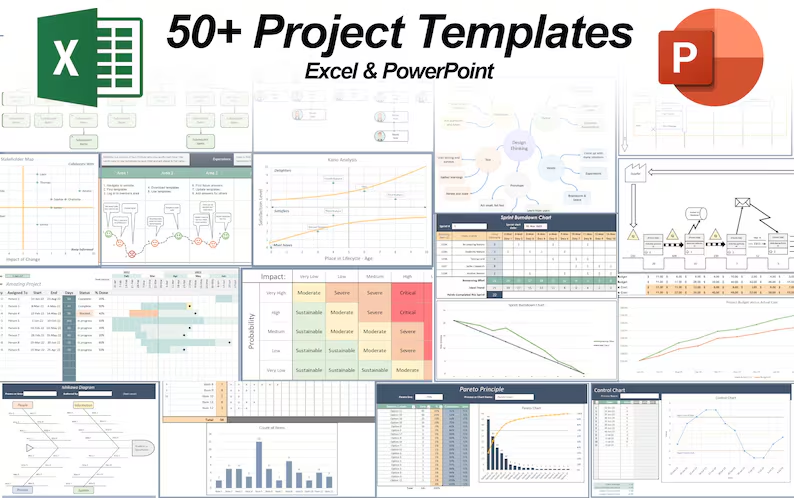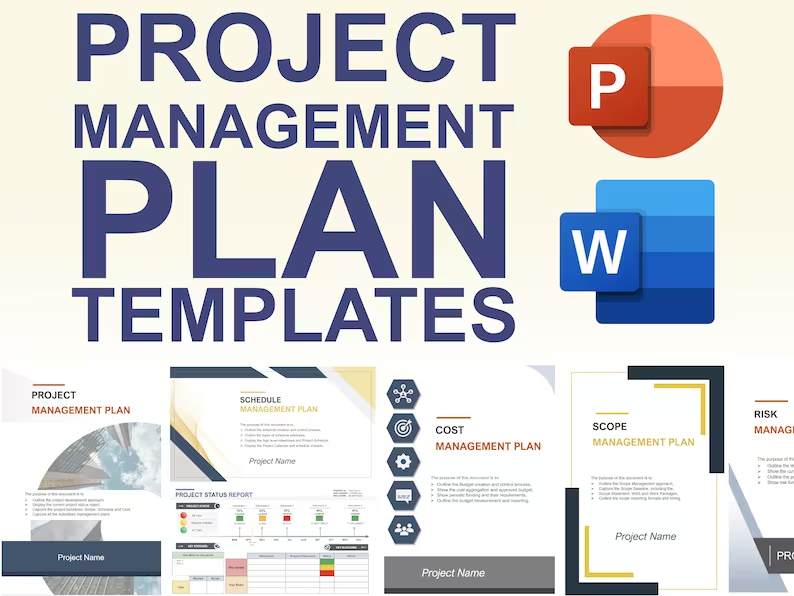 Agile vs. Waterfall Project Plans
Agile vs. Waterfall Project Plans
The debate between Agile and Waterfall project management methodologies is a common one, with some individuals favoring Waterfall and others preferring Agile. However, the ultimate goal remains the same: successfully completing a project.
Let’s check out the differences and similarities between Agile and Waterfall project plans, focusing on the tools used in each methodology. It’s important to note that neither approach offers a “free pass”—both require diligent management of scope, stakeholders, schedule, cost, and quality.
Starting a Project: Waterfall
In a Waterfall project, the process begins with creating a business case to weigh the pros and cons of starting or delivering a new product. This is followed by the development of a project charter, which officially kicks off the project with resources and funding from the project sponsor. Early planning documents in Waterfall projects include a change control plan, configuration management plan for version control, benefits management plan, and a comprehensive project management plan covering scope, schedule, cost, and quality.
Starting a Project: Agile
Agile projects, on the other hand, kick off with a team charter and a high-level model of the system, such as a sequence or architecture diagram. Agile methodologies can also use a walking skeleton, a basic version of the system to which features are gradually added. Other planning tools in Agile include the business model canvas or lean canvas, which outline customer problems, proposed solutions, value delivery methods, and competitive advantages.
Gathering Stakeholders: Waterfall
Waterfall projects involve extensive stakeholder planning. A stakeholder register is created to list all stakeholders, classify them by influence and impact, and outline engagement strategies. This detailed planning helps ensure effective communication and stakeholder management throughout the project.
Gathering Stakeholders: Agile
Agile projects also require stakeholder engagement but typically involve less documentation. A team charter outlines the project’s vision, mission, background, team roles, stakeholders, values, and communication and decision-making processes. Agile projects often feature small, co-located teams, typically around nine members, to facilitate quick communication and collaboration.
Gathering Requirements: Waterfall and Agile
Requirement gathering in Waterfall projects involves creating detailed documentation and a requirements traceability matrix to track requirements through to completion.
Agile projects, being more customer-focused, offer various methods for gathering requirements, such as the business model canvas, lean canvas, prototypes, mockups, storyboards, test cases, and acceptance criteria. Agile emphasizes iterative feedback and adaptation to meet customer needs.
Scope and Deliverables
In Waterfall projects, scope and deliverables are defined by a high-level scope description, prioritized features, a work breakdown structure (WBS), and a WBS dictionary detailing resources, costs, dependencies, and durations. The goal is to plan everything upfront, ensuring all work packages are defined before execution.
Agile projects use a product backlog, consisting of high-level epics and detailed user stories. Similar to a WBS, user stories are broken down into manageable tasks for each Sprint. Agile scope management includes mockups, storyboards, user story mapping, and prioritization methods like cost-benefit analysis. Scope is accepted through Sprint reviews, providing regular customer feedback.
Project Schedules
Waterfall schedules involve breaking down the scope into an activity list, sequencing activities, estimating durations, and creating a detailed schedule, often visualized in a Gantt chart.
Agile projects utilize a product roadmap, which can resemble a Gantt chart, to outline feature delivery timelines. Sprint planning determines the work for each Sprint based on team velocity and capacity. Progress is tracked using burn-up and burn-down charts.
Cost Management
Waterfall projects estimate costs for each work package, including contingencies for risks and management reserves for unforeseen scope changes, resulting in an approved baseline budget.
Agile projects typically operate on a fixed-cost model, with a stable, small team working within a set budget and timeframe. The product backlog is prioritized to deliver the highest value items within the fixed budget.
Quality Management
Quality in Waterfall projects is managed through a test and inspection plan, usually conducted at the end of the project.
Agile projects integrate testing throughout development, using techniques like test-driven development (TDD), code inspections, unit testing, and continuous delivery. Quality is verified through Sprint reviews and ongoing customer feedback.
Resource Management
Both methodologies require resource management. Waterfall projects estimate resource needs, create a resource breakdown structure, and assign roles and responsibilities using a responsibility assignment matrix (RAM).
Agile projects emphasize a whole-team approach, with co-located teams of T-shaped individuals possessing a broad skill set and deep expertise in one area. Agile teams use visual management tools and pair programming to enhance collaboration.
Procurement Management
Waterfall projects involve detailed procurement processes, including make-or-buy analysis, source selection criteria, and vendor management.
Agile projects prefer integrating necessary skills within the team but may use fixed-cost, variable-scope contracts to accommodate changing requirements.
Communication Management
Waterfall projects use communication management plans and communication styles assessments to tailor communication methods to stakeholder preferences.
Agile projects prioritize open communication with daily standups, Sprint planning, Sprint reviews, and retrospectives. Visual management tools and open team areas facilitate ongoing communication and collaboration.
Different, But the Same
While Agile and Waterfall project management methodologies differ in their approach, both aim to deliver successful projects. Waterfall focuses on extensive upfront planning and documentation, while Agile emphasizes flexibility, customer feedback, and iterative development. Understanding the strengths and weaknesses of each methodology helps project managers choose the best approach for their specific project needs.
See more PMP Articles and Tips for Passing your Exam:
- Explained: What Does a Business Analyst Do?
- Get David McLachlan’s Udemy Courses for $14.99 During March 2025
- Pass Your Exam With These 3 Powerful Psychology Tricks
- Want to Pass your PMP? Don’t Do These 6 Things
- What To Do If You Don’t Have A Product Owner
- Is the PMP Relevant in the Real World?
- The PMBOK Guide 8th Edition Draft – My Feedback
- Never Escalate, Never Close – Bad Advice for your PMP Exam
- The PMP Cheat Sheet – Are You Ready for the Exam?
- The PMP Fast Track
You can see what people are saying about David McLachlan here: REVIEWS
Navigate to Free Project Management and Leadership Articles through the links on the right (or at the bottom if on Mobile)



